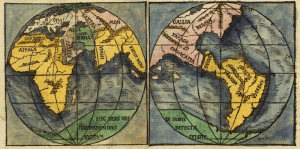 Game worlds are often a lot like our own world, save some modifications. They might even be countries we know but with the serial numbers filed off. When your homebrew world involves lived experiences outside your own, it’s easy to slap a skin on the world and just call it a day. But we can give our homebrew worlds a potency for roleplaying, an intense potential for story, if we do a little extra work, a little extra reading and listening.
Game worlds are often a lot like our own world, save some modifications. They might even be countries we know but with the serial numbers filed off. When your homebrew world involves lived experiences outside your own, it’s easy to slap a skin on the world and just call it a day. But we can give our homebrew worlds a potency for roleplaying, an intense potential for story, if we do a little extra work, a little extra reading and listening.
Part 5, Resources for Writing the Other
Where to start? Much of Nisi Shawl and Cynthia Ward’s book Writing the Other works surprisingly well in the context of game settings. You can apply it easily to your worldbuilding, interrogate your setting by asking questions about its societies, social movements, historical periods, and signature characters.
Polling your players, if they’re cool with acting as resources, is another option for getting out of your head and opening up the stories possible in your world. Their lived experiences can give you clues toward stories you may have not considered as possible in your world. I tend to push for worlds with a lot of room for player options: in terms of types of characters to play and the pressures that operate on them. If your homebrew world tightly limits the day-to-day and bigger choices characters can make, the room for choice then has to be more about characters’ internal thoughts and their smallest acts of rebellion. (The Handmaid’s Tale by Margaret Atwood is a good fictional example, and memoirs from people who live through colonial and/or occupational governments is a much wider resource in terms of real life time period/lived experiences.)
Now, because I tend to create our-world-but-different homebrews, my players have their pick of countries, schools, and life backgrounds, and they all look similar to what we know. But those changes to the real world are a place for them to build from. If magic is real, how do our societies change? Or the world over? If we know vampires walk among us, what does that do to insular communities that were already averse to trusting outside groups?
A favorite book series, Newsflesh by Mira Grant, portrays the aftermath of the zombie apocalypse as the world rebuilds, but there are still zombies. The way schooling, families, medicine, personal safety, media, even interior design change, all crop up across the books. When you’re radically altering something about our world, there are cascades of effects. In Newsflesh, the trauma of the generation that come of age during the summer of the Rising is there, every day. The generation too young to remember have inherited their cynicism, distrust, and a brutally unsafe world that has next to no resemblance to the world their parents knew. People don’t have pets or eat animals. No one decorates with any kind of skeletal art. The picture windows once an enviable feature in a house are no longer within building codes. Flight attendants can drug you. Good Samaritan laws take on a new, horrific dimension. The CDC is the highest law in the land. It’s a scary new world. And it’s easy with something as extreme as zombies, to figure out how that changes your world (and what it does to the internal lives of players’ characters). Staying with fiction, River of Teeth by Sarah Gailey introduces something to US history that results in a delightful and horrifying change of what we know (the government introduces hippos into the swamps of Louisiana as an alternate food source to be slaughtered).
If we page through silver and small screens, there’s an endless variety of alternate histories, particularly in US cinema and TV.
 Growing up, it took years for me to realize that when I read far away from my experiences, I would get to see new stories. It became easier to widen the stories and choices in my games as a GM when I had tools (like the Writing the Other book) to give me ideas about things I didn’t know about and how people with that knowledge base (examples of things I have no firsthand experience with include hunting, knowing how to fix a car, water rescue, flying through the wreckage of a sky over Berlin during WWII) are shaped by carrying that knowledge. The most ordinary parts of our lives (where we live, where we work, how we spend our time) can be dramatically different using something as “small” as the change of where we live, by as few as two blocks or the other side of a bridge. It is perilously easy for me to paint worlds in broad strokes, and I think that when I do so, it’s a disservice to the world I make and to my players. To have a real concept of choices, and how our choices differ, how they matter, I have to get out of my head. That’s why Writing the Other is a good first step, because it highlights all these places and all these ways we don’t necessarily find ourselves conscious of when we’re writing, about how we all live our lives, how those differences change us and our imagination.
Growing up, it took years for me to realize that when I read far away from my experiences, I would get to see new stories. It became easier to widen the stories and choices in my games as a GM when I had tools (like the Writing the Other book) to give me ideas about things I didn’t know about and how people with that knowledge base (examples of things I have no firsthand experience with include hunting, knowing how to fix a car, water rescue, flying through the wreckage of a sky over Berlin during WWII) are shaped by carrying that knowledge. The most ordinary parts of our lives (where we live, where we work, how we spend our time) can be dramatically different using something as “small” as the change of where we live, by as few as two blocks or the other side of a bridge. It is perilously easy for me to paint worlds in broad strokes, and I think that when I do so, it’s a disservice to the world I make and to my players. To have a real concept of choices, and how our choices differ, how they matter, I have to get out of my head. That’s why Writing the Other is a good first step, because it highlights all these places and all these ways we don’t necessarily find ourselves conscious of when we’re writing, about how we all live our lives, how those differences change us and our imagination.
For even more insights on on how to run your game, check out the many wonderful voices in Kobold Guide to Gamemastering.

Nice article